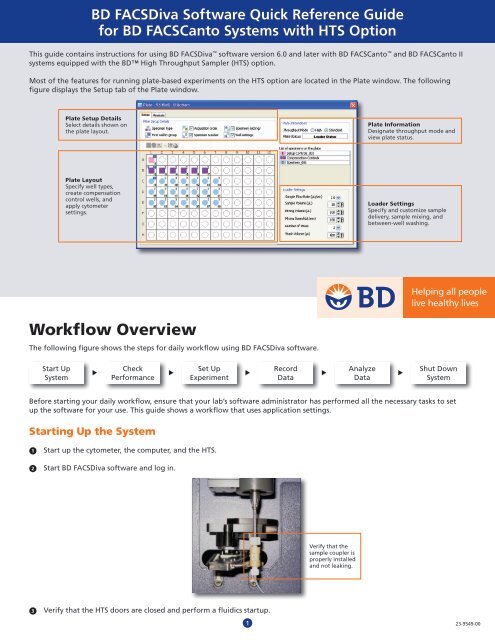BD Biosciences brand of digital flow cytometers, including the FACSCanto, the LSR-II, FACSAria and Fortessa, utilize a software acquisition program known as FACSDiva.
Open the BD FACSDiva software and log on. Allow the instrument to connect to the software if necessary. Click the New Experiment icon. Click the New Specimen icon. Expand the specimen and make the tube active by clicking the arrow next to the tube. The arrow will turn green.
Diva is aptly named as it can be a difficult program to master.
However, Diva has come along way over the past 10 years and many improvements have been made to help end-user.
Supports cell analysis for up to six parameters. The bd accuri c6 makes the analytical power of flow cytometry more accessible with ease of use. Acquisition and analysis. Bd facsdiva software. Bd facsdiva windows full featured user acquisition and analysis software for the bd facsaria ii. Currently there are two licenses the first is located. The system has been tested with the FCS files created by BD CellQuest, BD FACSDiVa software (version 5) and Beckman-Coulter Quanta software. BD FACSDiva sofware 5.0.1 on Macintosh via parallels Is it necessary? The answer is 'yes' to at least one of those questions: It's true. You can run DiVa on a mac. BD FACSDiva software provides new features to help users integrate flow systems into new application areas, including index sorting for stem cell and single-cell applications, as well as automation protocols for high-throughput and robotic laboratories. For Research Use Only. Not for use in diagnostic or therapeutic procedures.
Taking time to learn these changes will improve the reproducibility of your data, the chances of your data getting published, and your overall experience on the cytometer.
These changes will also save you time. Here are 8 time-saving FACSDiva tips to use the during your next flow experiment:
1. Compensation doesn’t require the ‘universal negative.’
It is important to remember that the background of the positive and negatives should be matched. The use of a universal negative will cause problems in compensation, especially if cells and beads are used for generating the compensation matrix.
In Diva, you can unselect the ‘use a separate tube for negative control’ when you’re setting up compensation. This will allocate the placement of a P3 gate on the single-stained histograms. Diva will then use the P3 gate as the negative population when calculating compensation.
2. Make multiple matrices.

In the case where several different antigens are being measured in the same channel, especially where the label is a tandem dye, it is critical to have a different compensation matrix for each tandem combination.

In Diva, when you create a compensation matrix, you can add additional columns of the channel in question, and label each one with the appropriate antigen name. Then, after collecting the controls and performing compensation, when you are finally collecting your samples, make sure each one is labeled with the same name. This will ensure that the proper compensation matrix is applied to each sample.
3. Collect more events.
Bd Facsdiva Cs&t Research Beads
When calculating compensation, don’t let the default of 5,000 events be your guide. When using compensation particles, 10,000-20,000 events is better. When using cells, 30,000-50,000 is better. A simple change in your DIVA layout can ensure that sufficient events are collected.
4. Create keywords.
Annotation of the data with keywords will help in finding data weeks and months after the experiments are run. Keywords are also useful when performing analysis in third party software for grouping and batch analysis. If you don’t know how to add keywords to your experiment, you are wasting valuable time that will affect your ability to reproduce and publish your data. Learn how to create keywords here.
5. Keep the Diva database clean.
Diva is based in Java, and the database size can have a negative impact on the speed of the software. It’s best to keep the data base seize well under 15 gigabytes. This means you need to export your experiments on a regular basis. It also means you need to back up your database before making major changes to your computer or the software program itself.
6. Limit the size of your data files.
Bd Facsdiva Software Download
With the ability to measure a million events in a few minutes, and with the occasional need to look at rare events, it is important to remember the size of file should be kept to a minimum.
The best practice is to collect three or four 1-2 million event files versus, for example, one 10 million event file. The data can later be joined (concatenated) in third party software platforms. But, during acquisition, to keep processing times reasonable, don’t let the file size get to big.
7. Read the Cytometer Setup & Tracking (CS&T) baseline report.

This report, which Diva provides, is full of useful information. The report includes suggestions for starting voltages, PMT dynamic ranges, and more.
When setting up a new experiment review these settings, especially the linear dynamic range of the PMTs. If your signals are outside of this range, then any compensation you apply to your cells will not be correct.
Bd Facsdiva software download, free
8. Use application specific settings.
Bd Facsdiva Support
When performing longitudinal studies, it’s essential that you maintain the optimal voltage of the instrument. This will ensure that any differences discovered will be the result of the biology of your cells, not the settings of your instrument.
Bd Facsdiva Software Download
Application specific settings should be finalized when the experiment is started. These settings are linked to the daily CS&T reports and, if the settings are correct, the software will make the appropriate adjustments in response to any instrument changes.